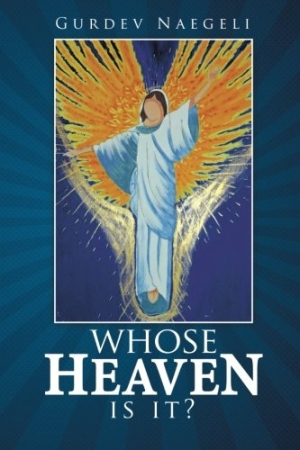Whose Heaven Is It?
Naegeli covers a great deal of territory in an effort to synthesize, and broadly understand, the world’s major religions.
World traveler Gurdev Naegeli’s debut, Whose Heaven Is It?, is an exploratory interreligious text that seeks to achieve harmony via understanding. It is an ambitious and often informative experiment in spiritual synthesis.
Naegeli begins with observations regarding humanity’s continual pursuit of meaning. Such impulses transcend religious affiliations, he asserts, as human beings have always sought to understand from whence they came. Naegeli puts religions into conversation with science on the topic of cosmology, showing how scholarship honors the complexity of life in a way compatible with religious wonder.
Science is afforded less space in subsequent chapters, which move to presume the existence of a creator, and therefore strain logic in answering pressing human questions from the world’s dominant religious traditions. Beneath topical headings from life cycles to politics, Naegeli presents the doctrinal bones of various religions, from Hinduism and Buddhism to Christianity and Islam.
On issues of salvation or the future of human souls, the author favors Eastern explanations, arguing that a one-chance shot in a world so full of inequality would not reflect a loving creator; on issues such as right and wrong, he finds common ground between various explanations of good and evil. Such conclusions form his “Spiritual Platform,” an encompassing means of entering the world thoughtfully and beneficially: “the Spiritual Platform therefore identifies the basic…values that are common. … It looks toward spiritual unity, not division, in a world which is now global.” This motivating impulse proves sympathetic, if readers may not always concur with all conclusions.
Ultimately, Naegeli’s project is weakened by its need to accomplish so much in a relatively limited space. His presentations of diverse traditions reflect research, but are not always perfectly informed or articulated. The book references six articles of Islamic faith, for example, and then names only four; simultaneously, it presumes that the full veil is incumbent on all Muslim women.
Judaism, which is treated as a subset of Christianity, fares the worst in this presentation, existing alternately as a Christian sect and as a strictly ancient tradition, its holy works poorly dated, its teachings subsumed by Christianity’s own. Readers should not, therefore, approach Naegeli’s text as a primer on the world’s religious traditions; it is best appreciated for the ways in which it seeks common ground, and not the ways in which it interprets traditions.
A chapter in which Naegeli is spirited off to a distant summit on the back of a blue bird proves to be weird and fantastic reading, itself seeming to be the beginning of a religious text. Couched among more sober chapters, it requires a shift in reader perception, however. Late chapters, on the Israeli-Palestinian conflict and on the ethical issues surrounding modern banking practices, are similarly interesting and challenging. An abrupt ending adds to the patchwork quality, and a final summation of the Spiritual Platform is missing.
A work estimable for its interreligious sympathies and broad pursuit of understanding, Whose Heaven Is It? does much to promote conversation and care, if it sometimes strays into surprising territory.
Reviewed by
Michelle Anne Schingler
Disclosure: This article is not an endorsement, but a review. The publisher of this book provided free copies of the book and paid a small fee to have their book reviewed by a professional reviewer. Foreword Reviews and Clarion Reviews make no guarantee that the publisher will receive a positive review. Foreword Magazine, Inc. is disclosing this in accordance with the Federal Trade Commission’s 16 CFR, Part 255.

